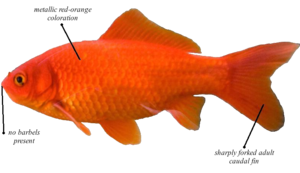Common Goldfish: Difference between revisions
imported>Drew R. Smith No edit summary |
imported>Drew R. Smith No edit summary |
||
| Line 18: | Line 18: | ||
Goldfish are noted for being messy, greedy feeders that produce a lot of waste. Needless to say they require a very efficient filtration system to cope with this. | Goldfish are noted for being messy, greedy feeders that produce a lot of waste. Needless to say they require a very efficient filtration system to cope with this. | ||
==Gallery== | |||
<Gallery> | |||
CommonGoldfishdiagram.png | |||
Juvenilegoldfish.png | |||
Common Goldfish.jpg | |||
Goldfish3.jpg | |||
BlackCommonGoldfish.jpg | |||
</Gallery> | |||
Revision as of 09:35, 11 September 2009
| Common Goldfish | |
|---|---|

| |
| Family | Cyprinidae |
| Size | Variable |
| Tank Level | Middle and Lower |
| Temperament | Peaceful |
| Tail Type | Single-tailed |
| Country of Origin | China |
Originating from the Prussian Carp, the Common Goldfish most likely emerged through a form of favoritism. As fish were once kept in captivity for food, fish-keepers may have learned to recognize individuals and then become attached to their charges, and it is likely that an occasional genetic sport, or non-standard colored fish, would appear and draw greater attention. Such fish would be segregated and kept for their appearance rather than their meat, and so the Common Goldfish slowly emerged.
Physical Description
Traditionally, the body color of the Goldfish is metallic red-orange with matching fins. Young fish may be greenish bronze, changing to adult coloration after about one year. Dorsal and anal fins are relatively long based, and the caudal fin is forked and stiffly held. The lateral line is visible. Females usually appear plumper when they are viewed from above. At spawning time the male develops small white spots (tubercles) on the gill covers and head.
History
Kept by man since the 11th century, Carassius auratus (the goldfish) is probably the best known of all aquarium or pond fishes. The wild form of this fish is the dull green to brown Prussian Carp, with little to recommend it as a potential aquarium fish, but a mutation occurred which developed lovely gold patches on the body which eventually turned the whole fish gold. The goldfish's first recorded breeding in Europe took place in Holland in 1728, but in its native China it has been domesticated since around the 11th century AD.
In the aquarium
In the aquarium the goldfish will inhabit the middle and lower levels, and eats flakes, vegetation, live foods, and bloodworms. They are generally peaceful, and can grow up to two feet long. However, if placed in an aquarium that is too small, the goldfish will stop growing when it runs out of room. When this happens the internal organs do not stop growing, causing a painful, stunted death for the fish. Generally speaking a goldfish should be placed no more than nine inches of fish (two four-and-a-half inch fish, or one nine inch fish) per 10 gallons of water.
Goldfish are noted for being messy, greedy feeders that produce a lot of waste. Needless to say they require a very efficient filtration system to cope with this.





